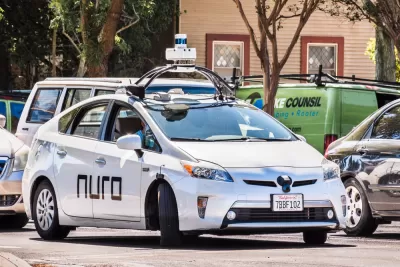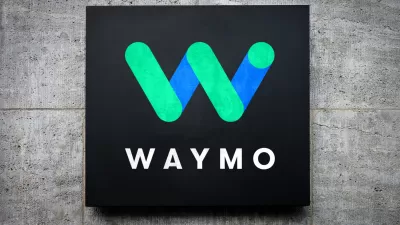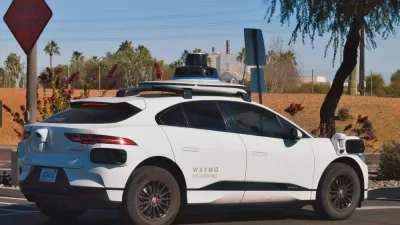A new white paper provides a foundation for public sector agencies to approach autonomous vehicle deployment and policy with a focus on equity.

Just a year or so ago, it seemed that fleets of autonomous vehicles (AVs) would soon be deployed on city streets providing a robo-taxi service like Uber and Lyft — just without a driver. The timeline for commercial deployments of AVs has been significantly delayed by the technological challenges associated with safely deploying driverless vehicles, as well as by the COVID-19 pandemic. Even during the pandemic, however, automakers and technology companies continue to conduct research and test a range of autonomous vehicles — freight trucks on freeways, passenger vehicles on city streets, and smaller vehicles transporting goods on streets, in bike lanes, and on sidewalks — to develop commercial use cases and prepare for deployment.
AV technology has the potential to have major impacts on cities, both positive and negative. AVs could increase safety and help reduce congestion and pollution, but they could very well exacerbate existing inequities if they are simply layered on to the transportation ecosystems that exist today. Though the timeline is uncertain, communities across the United States understand that they need to plan for AVs before they arrive in order to maximize the potential benefits. The current moment provides an opportunity for the public sector to be proactive in shaping the deployment, applying lessons learned from the deployment of transportation network companies (TNCs), e-scooters, and other new mobility technologies.
With support from the Knight Foundation, the cities of Detroit, Pittsburgh, San Jose, and Miami-Dade County in Florida — the “cohort” — are actively working to understand how AVs can be deployed in ways that reflect community input and meet local needs. They are working with residents, employees, and business and community leaders to better understand mobility needs and how AV deployment can help achieve community goals.
The Urbanism Next Center at the University of Oregon, with Cityfi, is working with the cohort on the Knight AV Initiative and collecting important lessons learned throughout the project. A primary goal of the project is to understand how community engagement efforts can shape AV pilot projects taking place in the four cohort communities so that the deployment of AVs advances equity. To organize our thinking, Urbanism Next created an AV Initiative Framework for the project, as shown in Figure 1. In order for AVs to be deployed in ways that advance equity outcomes, we believe there are two areas that the public sector needs to focus on concurrently: identifying community needs and shaping deployment.
- To identify community needs, public sector agencies should engage community members in ways that prioritize the voices of marginalized groups to understand their mobility needs.
- To shape deployment, the public sector should determine which governmental approach they want to take with private sector companies interested in deploying AVs and understand the tools and levers they have at their disposal to ensure that AV services are deployed in a manner that helps achieve community transportation and equity goals.
In this paper, we outline our current understanding of community engagement best practices, important AV-related equity topics, different models of governance, and the tools and levers local governments have to shape deployment.
It is important to note that this document is not a comprehensive framework for planning for autonomous vehicles. A number of other organizations have developed robust guidance on planning for AVs, such as NACTO’s Blueprint for Autonomous Urbanism (Second Edition), National League of Cities’ Autonomous Vehicles, A Policy Preparation Guide, The Greenlining Institute’s Autonomous Vehicle Heaven or Hell?: Creating a Transportation Revolution That Benefits All, and others. Instead, the purpose of this white paper is to provide a foundational understanding of the two-pronged public sector approach we believe is necessary for AVs to be deployed in ways that advance equity outcomes. While it was drafted specifically for the AV Initiative, this framework can be a guide for local and regional agencies that want to develop strategies and activities to deploy AVs with equity as the guiding principle.
FULL STORY: A Framework for Shaping the Deployment of Autonomous Vehicles and Advancing Equity Outcomes

Planetizen Federal Action Tracker
A weekly monitor of how Trump’s orders and actions are impacting planners and planning in America.

Chicago’s Ghost Rails
Just beneath the surface of the modern city lie the remnants of its expansive early 20th-century streetcar system.

San Antonio and Austin are Fusing Into one Massive Megaregion
The region spanning the two central Texas cities is growing fast, posing challenges for local infrastructure and water supplies.

Since Zion's Shuttles Went Electric “The Smog is Gone”
Visitors to Zion National Park can enjoy the canyon via the nation’s first fully electric park shuttle system.

Trump Distributing DOT Safety Funds at 1/10 Rate of Biden
Funds for Safe Streets and other transportation safety and equity programs are being held up by administrative reviews and conflicts with the Trump administration’s priorities.

German Cities Subsidize Taxis for Women Amid Wave of Violence
Free or low-cost taxi rides can help women navigate cities more safely, but critics say the programs don't address the root causes of violence against women.
Urban Design for Planners 1: Software Tools
This six-course series explores essential urban design concepts using open source software and equips planners with the tools they need to participate fully in the urban design process.
Planning for Universal Design
Learn the tools for implementing Universal Design in planning regulations.
planning NEXT
Appalachian Highlands Housing Partners
Mpact (founded as Rail~Volution)
City of Camden Redevelopment Agency
City of Astoria
City of Portland
City of Laramie





























